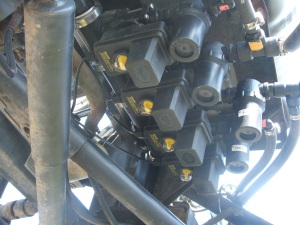Friday I spent some time getting the sprayer ready for post planting pesticide application, a process that should be taken seriously to ensure that pesticide applications that are made are made accurately to avoid overapplication or underapplication of the product you are spraying.
I start of by putting water in the spray tank and spraying out some water without the spray nozzles being on to flush out any debris that might be in the system. After I have done this, I will put the nozzles on and spray out some more water, checking to see if any of the nozzles are plugged. After I am sure all nozzles are working properly, I check the flow from each nozzle to be sure that each nozzle is in proper working order, that the flow is not higher or lower than it should be. To do this, I figure what the flow rate should be per nozzle. I apply 10 gallons of liquid per acre and travel at a speed of 11 miles per hour. There is a formula to do this:
After I am sure all nozzles are working properly, I check the flow from each nozzle to be sure that each nozzle is in proper working order, that the flow is not higher or lower than it should be. To do this, I figure what the flow rate should be per nozzle. I apply 10 gallons of liquid per acre and travel at a speed of 11 miles per hour. There is a formula to do this:
| GPM = | GPA x S x W 5,940 |
Where
GPM = nozzle flow rate (gallons per minute)
GPA = sprayer application rate (gallons per acre), as selected in Step 1.
S = speed (miles per hour), as selected in Step 2.
W = width sprayed by each nozzle (inches), as determined in Step 3.
5,940 = a constant for conversion of units
For my situation it figured out to be .37 gallons per minute per nozzle, or 47.3 ounces per minute per nozzle. I then use a measure to collect water from each nozzle for 30 seconds, where I should collect just under 24 ounces of water. You should do this for each set of nozzles that might be used during the season. Any nozzles that do not put out the correct amount, or have a spray pattern that is not correct must be replaced. It is important to select the proper nozzles when spraying, depending on the product being sprayed, to ensure proper liquid droplet size to ensure proper coverage of product on the target, while minimizing spray drift.
Flat Fan spray nozzle and it's spray pattern
Some of the equipment on a sprayer that helps to ensure proper application is a flowmeter, which measures the flow of product to the nozzles, a control valve that opens and closes as the speed of the sprayer changes to keep a constant flow to the nozzles, a controller that takes feedback from the flowmeter to tell the control valve whether to open or close, and valves to shut off sections of the boom.
This sprayer is also going to be equipped with auto-boom, which uses GPS to automatically shut off parts of the spray boom as you come to places that have already been sprayed, so that you don’t spray something more than once. The display used for this is also used with the planter to shut off planter rows when you come to places that have already been planted.
Following these steps allows farmers to make sure their equipment is in proper working order for the spraying season, and helps to ensure proper application of pesticides, which is important environmentally and economically.




